China and Korea | Study Guide Images
View the study guide images for this region. You can access each study guide image and its information by clicking on the corresponding tab. Feel free to rearrange the tabs by clicking and dragging them over one another. Click on the menu icon to reset the accordion. Hovering over the menu icon allows you to navigate to a study guide image you wish to see.
Guang
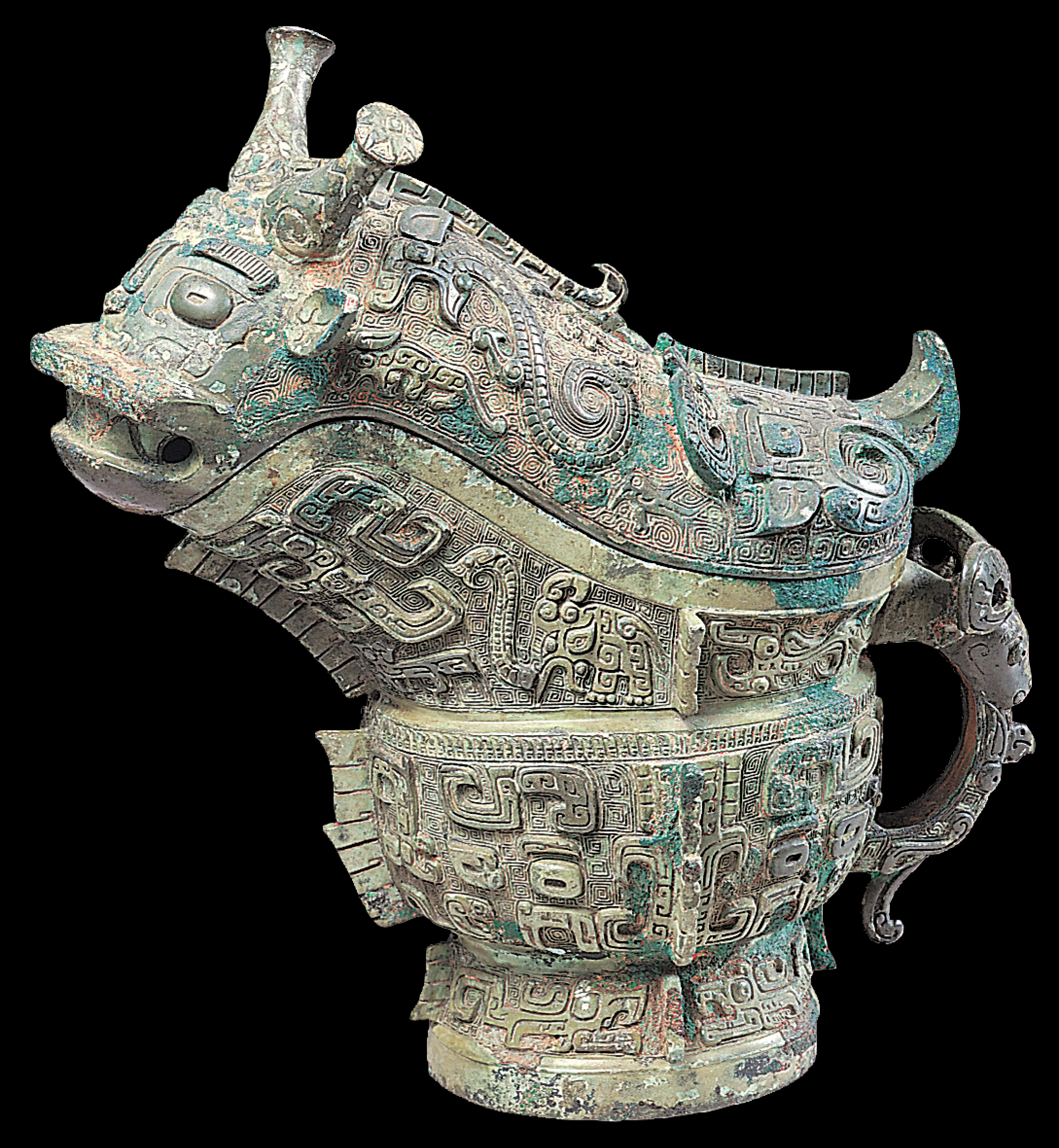
Guang: Bronze, 6 ½″ high.
found in Anyang, China
Shang Dynasty
ca. 1600 BCE – 1050 BCE
Your eBook, Kleiner Art Through the Ages, 15th edition, describes the image as follows. "Among the finest bronzes of the second millennium BCE are those that Shang artists created using piece molds. The Shang bronze-workers began the process by producing a solid clay model of the desired object. When the model dried to durable hardness, they pressed damp clay around it to form a mold that hardened but remained somewhat flexible. At that point, they carefully cut the mold in pieces, removed the pieces from the model, and baked the pieces in a kiln to form hard earthenware sections. Sculptors then carved the intricate details of the relief decoration into the inner surfaces of the piece molds. Next, the artists shaved the model to reduce its size to form a core for the piece mold. They next reassembled the mold around the model using bronze spacers to preserve a void between the model and the mold—a space equivalent to the layer of wax used in the lost-wax method (see “ Hollow-Casting Life-Size Bronze Statues ”). The Shang bronze-casters then added a final clay layer on the outside to hold everything together, leaving open ducts for pouring molten bronze into the space between the model and the mold and for venting gases. Once the mold cooled, they broke it apart, removed the new bronze vessel, and cleaned and polished it."
This is a prime example of a large category of food and wine vessels, cast in bronze, that were used for rituals in ancient, bronze-age, China.
Form
Guang an (animal shaped) pouring vessel with a large cover and a handle opposite the spout. In the mature form from the late-Shang dynasty, this common vessel has a hollow “foot” or base, a large, round belly to contain the contents, a large, wide pouring spout, sturdy handle, and a heavy lid, or cover.
Style
Zoomorphic: fanciful, abstract, animal-shaped forms, some from nature, some from the imagination (?), successfully integrated into an overall, coherent design characterized by symmetry. Individual “motifs” – how many can you identify?
Tao-tie a common element of Shang design: “animal-mask” a face organized by loosely reticulated shapes (ears, horns, open maws, bodies) around two large protruding “eyes.” A repetitive, squared off spiral pattern defines the “negative” space.
Meaning
The meaning of the ritual vessel is clear: it was used to hold items of consumption (for spirits, and possibly also living persons) in elaborate ceremonies or rituals performed by the Shang King, presumably to honor the ancestors, and the recent dead.
The meaning of the design is presumed to reflect the important role of animals in Shang society, but exactly what that purpose is, is not clear: one theory is that these are totem animals like those in Northwest Coast native American cultures.
Context
The Chinese bronze-age, of which the Shang represents an early mature period, was a time of high cultural sophistication, with writing systems, bronze-casting, multiple forms of arts and crafts supporting a stratified society with an elite at the top, ruled by a king/shaman. The technique, “piece-mold” (please explore fully) used in casting the “Shang bronzes” was indigenously developed in China, as evidenced by its uniqueness, and not imported from the west.
Shang and Zhou Dynasties: The Bronze Age of China
Princeton University Art Musuem: Bronze Casting
Funeral Banner
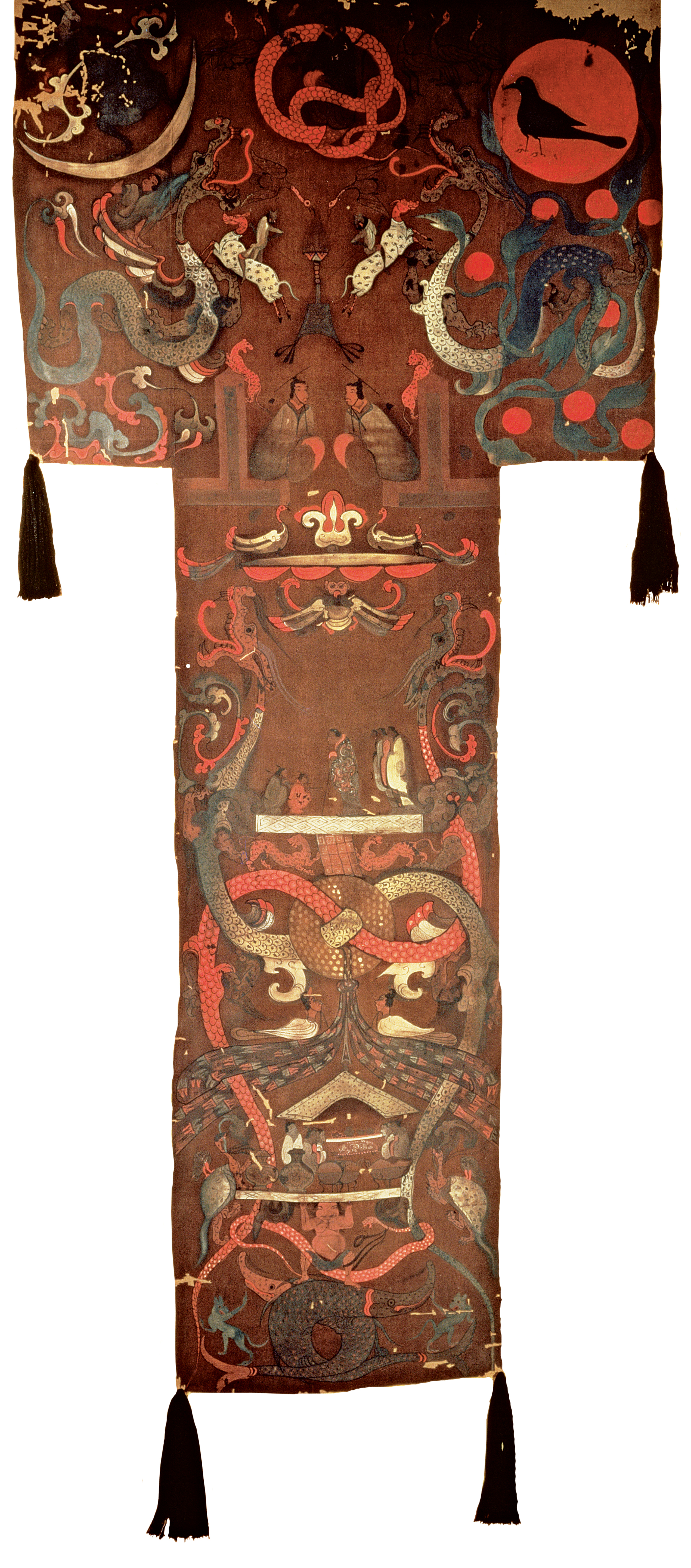
Funeral Banner:
Painted silk, 6′ 8 ¾″ x 3′ ⅓″
found in Tomb 1, tomb of the marquise of Dai, Mawangdui, China
Han Dynasty
206 BCE - 220 CE
Your eBook, Kleiner Art Through the Ages, 15th edition, describes the image as follows. "Silk is the finest natural fabric ever produced. It comes from the cocoons of caterpillars called silkworms. The manufacture of silk was a well-established industry in China by the second millennium BCE, and early examples of painting on silk—for example, the Han silk banner of the marquise of Dai—have fortuitously been preserved. The basic procedures probably have not changed much in almost 4,000 years. Farmers today still raise silkworms from eggs, which they place in trays. The farmers also must grow mulberry trees or purchase mulberry leaves, the silkworms’ only food source. Eventually, the silkworms form cocoons out of very fine filaments they extrude as liquid from their bodies. The filaments soon solidify with exposure to air. Before the transformed caterpillars emerge as moths and badly damage the silk, the farmers kill them with steam or high heat. They soften the cocoons in hot water and unwind the filaments onto a reel. The filaments are so fine that workers generally unwind the threads from 5 to 10 cocoons together to bond into a single strand while the filaments are still soft and sticky. Later, the silk-workers twist several strands together to form a thicker yarn and then weave the yarn on a loom to produce silk cloth. Both the yarn and the cloth can be dyed, and the silk fabric can be decorated by weaving threads of different colors together in special patterns (brocades) or by stitching in threads of different colors (embroidery). Many Chinese artists painted directly on plain silk."
This is a rare, very early example of Chinese painting on silk. It is unique, the only one found so far. It dates to the late Bronze Age, long after Shang.
Form
A T-shaped hanging banner with tasseled corners.
Style
Combination of abstract, cloud form designs, and simple representations of fantastic animals, and human forms. Faces frontal, ¾ view, and profile. The space appears to be roughly divided into thirds, with different narrative scenes depicted in each space.
Meaning
This banner was found on the coffin of an aristocratic woman, known as the Marquise of Dai, discovered in 1972, along with numerous other grave offerings in a remarkably well-preserved tomb in south china. It may have been carried aloft in her funeral procession and then buried with her. It depicts an aspiration: to be received into a celestial sphere (the upper portion of the scene). Below this is a scene of the Marquise in life. And below that is a scene from her funeral rite.
Examine the image carefully and explore all the details: what do you learn about her, and about Chinese views of the afterlife before Buddhism arrives?
Context
The Han Dynasty was an extensive empire. The unification of the various states, which was first achieved by the Qin emperor in the early 3rd Century CE., included a large geographic area north/south, east/west, which brought it into contact with India and Central Asia and, through the trade route known as the Silk Road, with the West. Many features of Chinese culture, such as the civil-service examinations based on the Confucian Classics, and the bureaucracy, writing forms, etc., were established in the Han. Many rich cultural artifacts, mostly small-scale grave goods (as a repudiation of the excesses of Qin Shi Huangdi), ceramics, lacquer, textiles, bronzes, reveal the love of life, and even humor of the Han peoples.
Shakyamuni Buddha
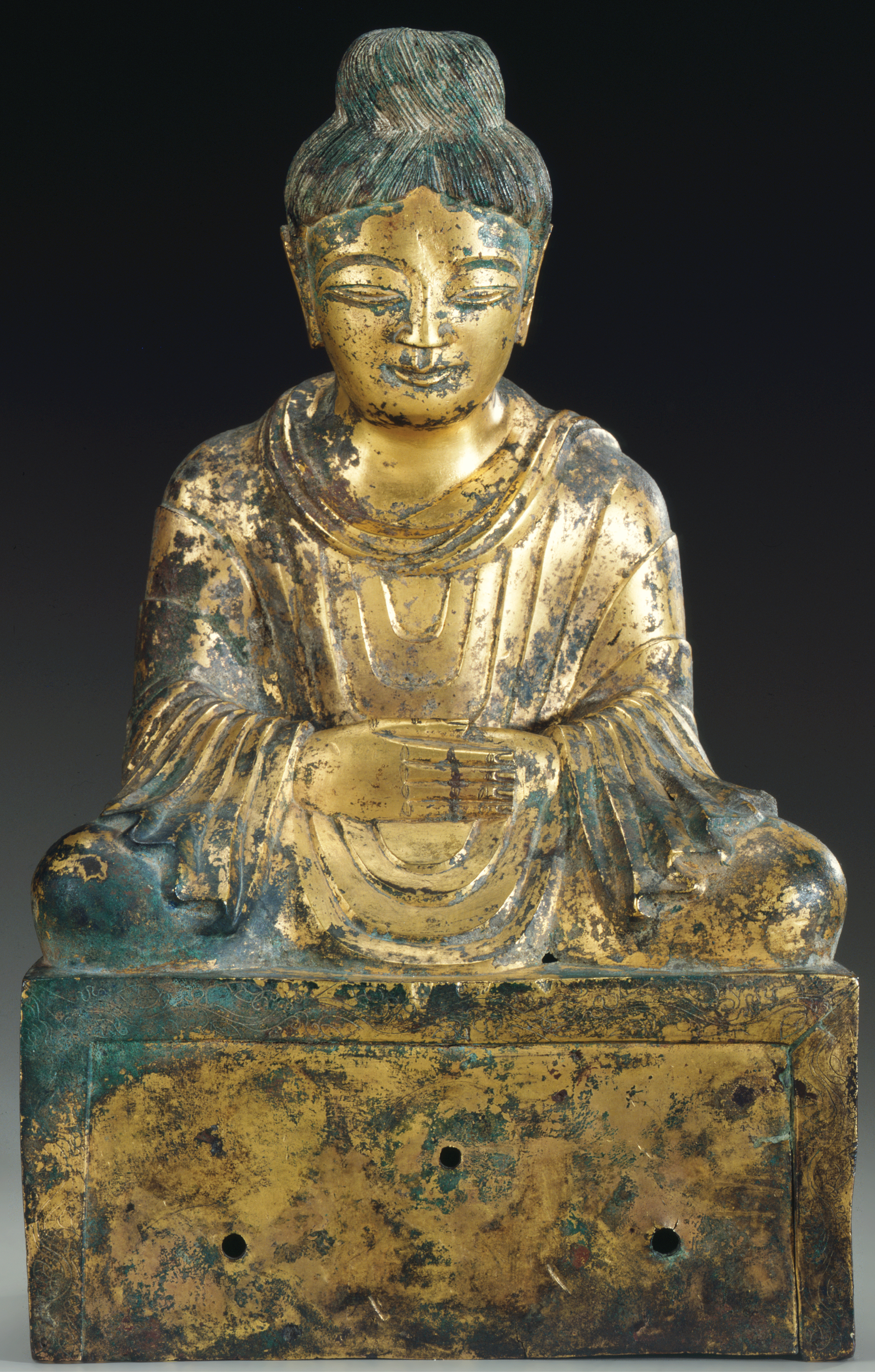
Shakyamuni Buddha: Guilded bronze, 1′ 3 ½″ high.
found in Hebei Province
Later Zhao Dynasty
319 CE - 351 CE
Your eBook, Kleiner Art Through the Ages, 15th edition, describes the image as follows. "A gilded bronze statuette in San Francisco representing Shakyamuni, the historical Buddha, bears an inscription giving its date as 338. Although some scholars have argued that the inscription is a later addition, many art historians accept the statuette as the earliest precisely datable Chinese image of the Buddha, created during the Later Zhao dynasty (319–351). The oldest Chinese Buddhist texts describe the Buddha as golden and radiating light. This no doubt accounts for the choice of gilded bronze as the sculptor’s medium. In both style and iconography, this early Buddha resembles the prototype conceived and developed at Gandhara. The Chinese figure recalls its presumed South Asian models in the flat, relieflike handling of the robe’s heavy concentric folds; the ushnisha (cranial bump) on the head; and the cross-legged position. So new was the iconography and its meaning, however, that the Chinese sculptor misrepresented the canonical dhyana mudra, or meditation gesture (see “ The Buddha, Buddhism, and Buddhist Iconography ”). Here, the Buddha clasps his hands across his stomach. In South Asian art (for example), the Buddha turns his palms upward, with thumbs barely touching in front of his torso."
This is the earliest, extant, dated, gilt-bronze image of the Buddha, to have been found in China.
Form
The Buddha is the conventional, universal, seated, yoga position. The small size suggests it might be a portable, private object of devotion.
Style
A local variant of the Indian Gandharan-style imported from northern India/Pakistan. Compared with the Meditating Buddha from Pakistan, a good example of the Gandharan-style, what changes does the Chinese artist make? Why?
Meaning
The Buddha in meditation. This would have been an expensive object to produce and not owned by anyone but a person, or community of means.
Context
Buddhism was established in China, probably by the late Han Dynasty brought by traders and missionaries. The teachings of Buddhism clashed in some ways with established philosophies of Daoism and Confucianism, but succeeded in earning many converts, especially during times of trouble. The period of Disunity, was one of those 3 times; foreign invaders occupied parts of north China and ruled as the Wei Dynasty; these rulers were fervent Buddhists and sponsored many large Buddhist monasteries and centers.
The Spread of Buddhism Among the Chinese
Daoism
Confucianism
Explore the Buddhis Art of Central Asia along the Silk Road.
The Buddhas of Bamiyan Valley, Afghanistan, destroyed by the Taliban in 2001.
Buddhas of Bamiyane
Flashback: The Destruction of the Buddhas of Bamiyan
Lady Feng and the Bear
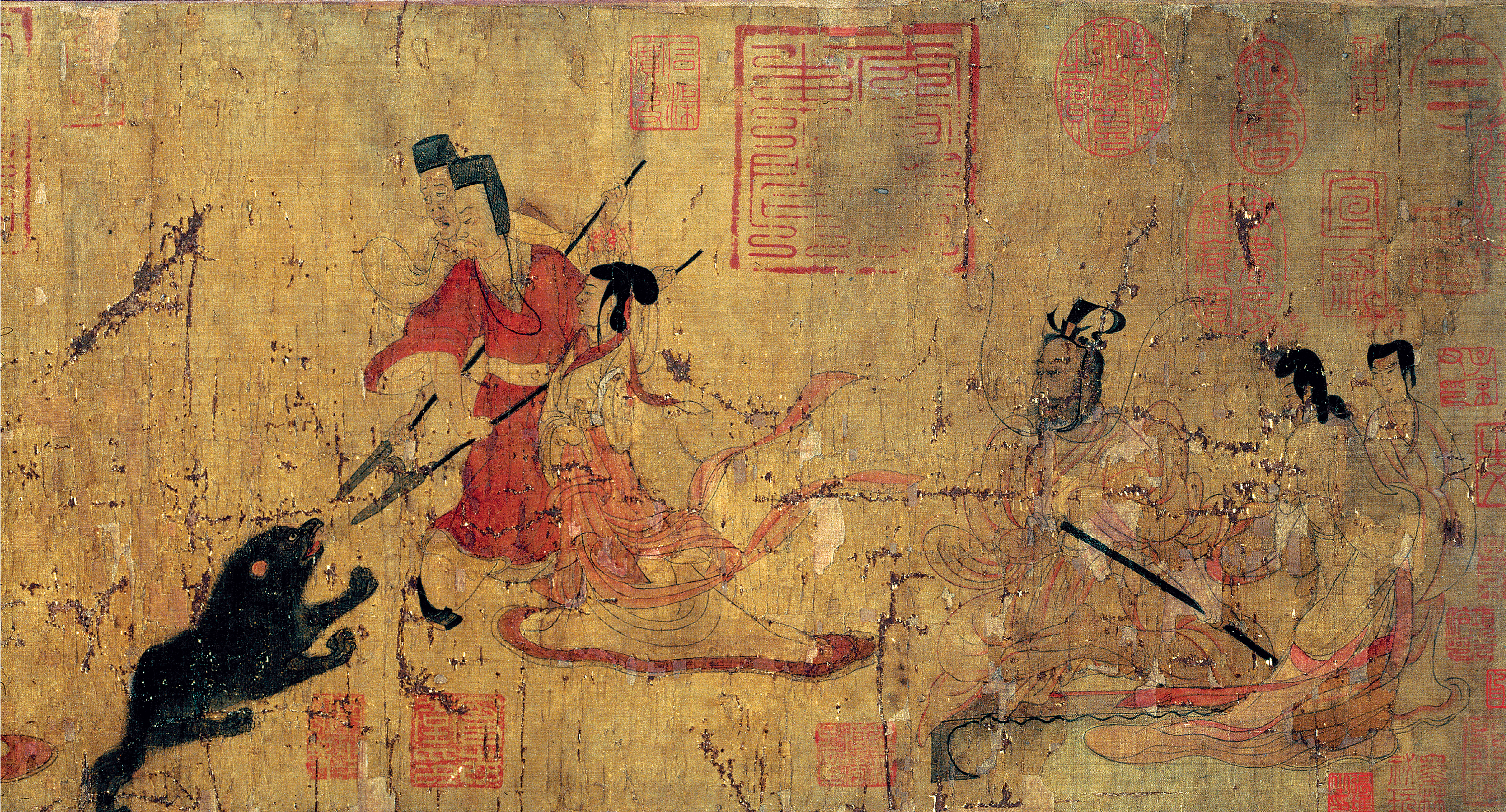
Lady Feng and the Bear: Handscroll, ink and colors on silk, 9 ¾″ x 11′ ½″
found in Loyang(Luoyang), western Henan Province
Period of Disunity
220 CE- 581 CE
Your eBook, Kleiner Art Through the Ages, 15th edition, describes the image as follows. "China has a long and rich history of scholarship on painting, preserved today in copies of texts from as far back as the fourth century and in citations to even earlier sources. Few of the first texts on painting survive, but later authors often quoted them, preserving parts of some important works for posterity. Thus, educated Chinese painters and their clients could steep themselves in a rich art historical tradition. Perhaps the most famous subject of later commentary is the set of six “canons” (laws) of painting that the art critic and painter Xie He (active ca. 500–530) formulated in the early sixth century. The canons, as translated by James Cahill, are as follows:
- Engender a sense of movement through spirit consonance.
- Use the brush with the bone method.
- Responding to things, depict their forms.
- According to kind, describe appearances [with color].
- Dividing and planning, positioning and arranging.
- Transmitting and conveying earlier models through copying and transcribing. *
Xie employed only four characters for each of these succinct and cryptic laws. Several variant translations have been proposed, and scholars actively debate the precise meaning of each canon. Interpreting the canons in connection with extant paintings is often difficult, but nonetheless offers valuable insights into what the Chinese of Xie’s day and later valued in painting."
This horizontal scroll painting has been traditionally attributed to the historically renown, early Chinese painter, Gu Kaizhi. It depicts a text written to instruct ladies in how to behave in their role as wives and concubines of the Emperor. Although it is likely a copy of two-three hundred years later, it is thought to faithfully represent Gu’s style and manner of painting.
Gu Kaizhi
Form
A handscroll – a unique Chinese format, a long, horizontal strip of silk (or, paper) that is unrolled from right to left, following the way the Chinese language is written, from right to left. The form allows the artist to create discrete scenes, one after the other, with some break between them, or to create a continuously unfolding composition that shares space. The act of unrolling to view creates an early form of time-based art.
Style
Gu’s style is mainly seen in his figure painting: long, willowy, narrow female bodies, covered in heavy layers of robes that trail on the ground around them, and diaphanous belts or scarves that are lifted in the air by the slightest movement. Elongated, narrow faces squared off at the forehead by their hair and rounded at the chin. The style is essentially linear, with the forms indicated by fine black outlines, then filled in with translucent colors. Space is not well defined; there is no “ground line;” space is indicated by position and overlap. How else is the solid ground implied?
Meaning
The painting consists of a series of short textual passages followed by Gu’s illustration of what that might look like in action, or how it was exemplified in the past.
Context
The inherent meaning is related to Confucian ideas of social duty, proper comportment, and formality among people. Confucius felt art’s role was to instruct.
Shakyamuni and Prabutaranta
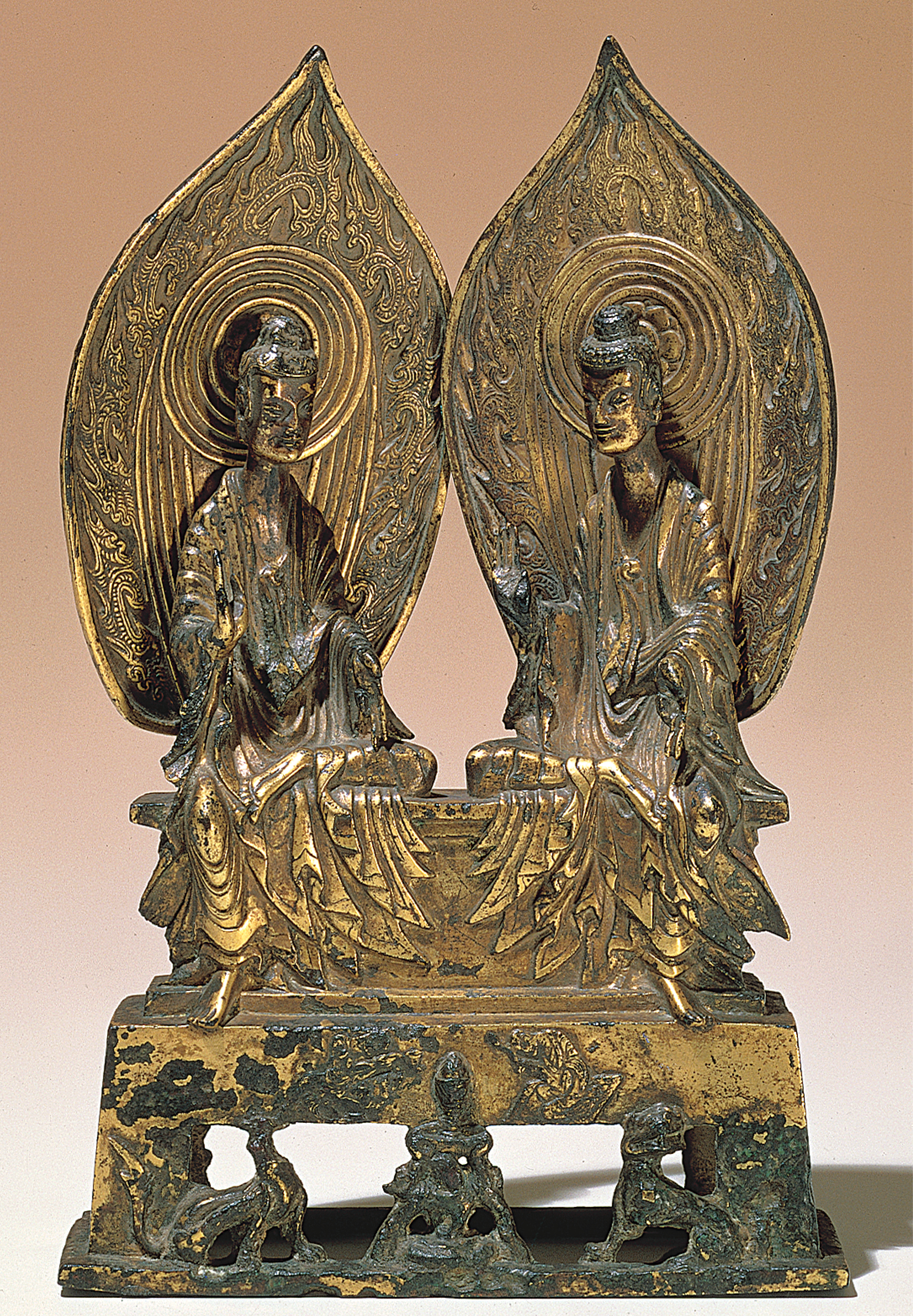
Shakyamuni and Prabutaranta: Gilded bronze, 10 ¼″ high.
found in Hebei Province, China
Northern Wei Dynasty
386 - 534 CE
Your eBook, Kleiner Art Through the Ages, 15th edition, describes the image as follows. "Behind each Buddha is a mandorla (flamelike almond-shaped nimbus). Both figures sit in the lalitasana pose—one leg folded and the other hanging down. This standard pose, which indicates relaxation, underscores the ease of communication between the two Buddhas. Their bodies have elongated proportions, and their smiling faces have sharp noses and almond eyes. The folds of the garments drop like a waterfall from their shoulders to their knees and spill over onto the pedestal, where they form sharp ridges resembling the teeth of a saw. The rhythmic sweep and linear elegance of the folds recall the brushwork of contemporaneous Chinese painting."
This is an excellent example of the abrupt change in the style of Buddhist art in China as the older Gandharan-style models were left behind in the north and artists adapted to the Court styles practiced in the south, exemplified by the elongated, linear style of Gu Kaizhi.
Wei dynasty
Form
Two Buddhas seated side by side; a small scale, gilt-bronze image, dated.
Style
Gu’s style; compare this image with Study Guide 18. Note all the differences.
Meaning
Iconography – an incident from the canonical Life of the Buddha: after his enlightenment, Shakyamuni, aka. The historical Buddha was preaching when a stupa containing a Buddha of the Past, Prabhutaratna, appeared in the sky. Together, these two Buddhas expounded for the crowds the tenets of the Lotus Sutra, one of the most popular texts of Buddhism in Asia, with a large following even today. The unusual pose, which originates in India, indicates comfortable informality.
Lotus Sutra
Context
The evolution of Buddhist art in China; its reach and importance, signified by the costs of the material, gilt-bronze. This style is uniquely Chinese and has nothing borrowed from India. Temporarily this style will influence Korea, and from Korea, Japan, both of whom will lag behind China stylistically for about a century until the Tang Dynasty.
Shakyamuni Buddha
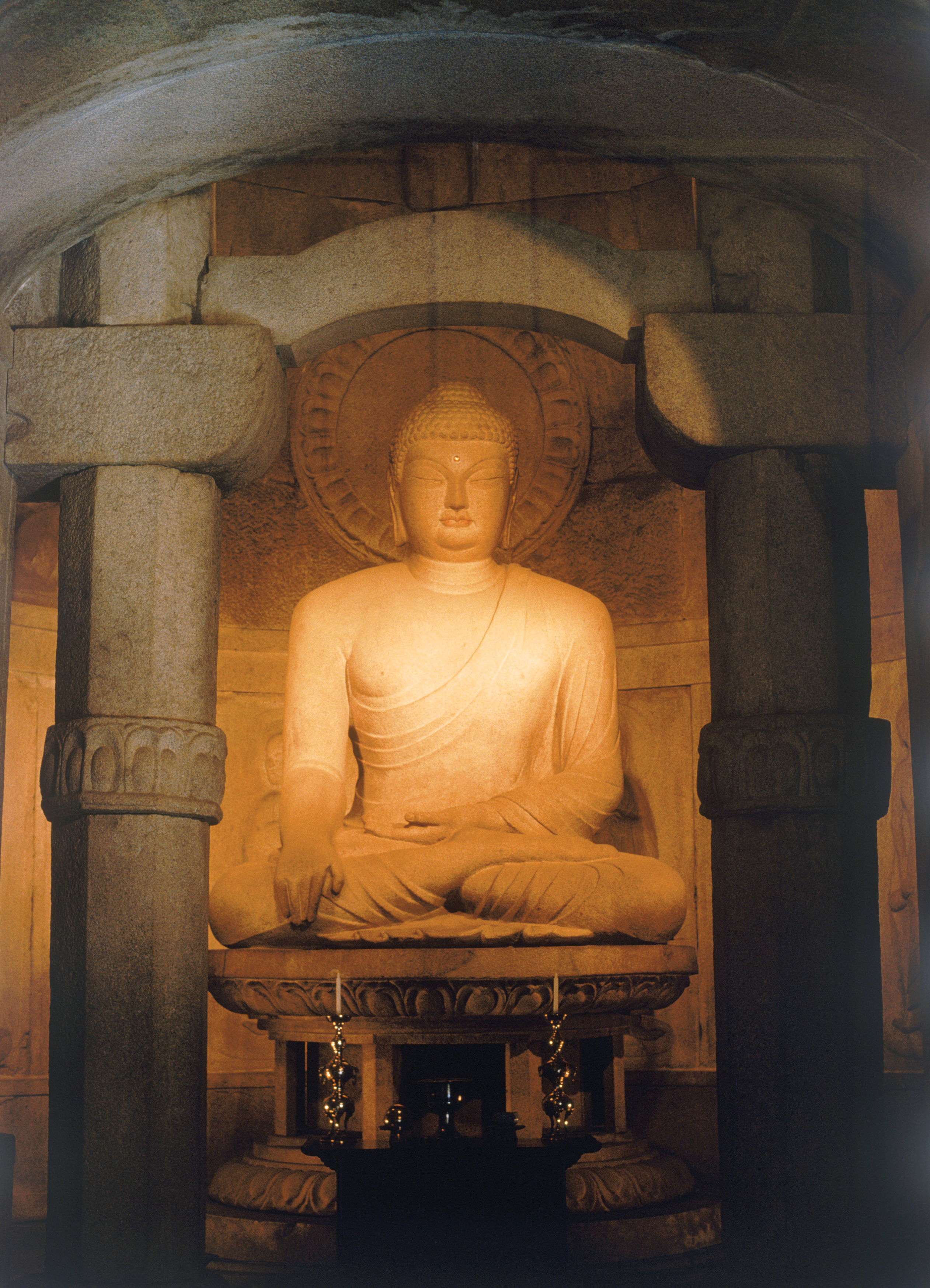
Shakyamuni Buddha: Stone, 11′ 3 ½″ high.
found in Seokguram, South Korea
Unified Silla Kingdom
668 CE - 935 CE
Your eBook, Kleiner Art Through the Ages, 15th edition, describes the image as follows. "The main rotunda (circular area under a dome) measures about 21 feet in diameter. Despite its modest size, the Seokguram project required substantial resources. Unlike the Chinese Buddhist caves at Yungang, Longmen, and Dunhuang, the interior wall surfaces and sculpture were not cut from the rock in the process of excavation. Instead, workers assembled hundreds of granite pieces of various shapes and sizes, attaching them with stone rivets instead of mortar.
Sculpted images of bodhisattvas, lohans, and guardians line the lower zone of the wall. Above, 10 niches contain miniature statues of seated bodhisattvas and believers. All these figures face inward toward the 11-foot-tall statue of Shakyamuni, which dominates the chamber and faces the entrance. Carved from a single block of granite, the image represents the Buddha as he touched the earth to call it to witness the realization of his enlightenment at Bodh Gaya. Although remote in time and place from the Sarnath Buddha in India, this majestic image remains faithful to its iconographic prototype. More immediately, the Korean statue draws on the robust, round-faced figures of Tang China, and its drapery is a more schematic version of the fluid type found in Tang sculpture. However, no close precedents exist for the figure’s distinctly broad-shouldered dignity combined with harmonious proportions. Art historians consider this Korean statue one of the finest images of the Buddha in East Asia."
This very large, stone sculpture of the Buddha is in situ in South Korea. It is an example of yet another stylistic development in Buddhist art that took place in the 7th Century of the Chinese Tang Dynasty, and was transmitted to both Korea and Japan.
Form
The canonical form of a seated Buddha, raised on a large lotus platform. The scale is well over life size.
Style
Tang Style. This style is the direct result of the reintroduction of Indian influence in China. Under Indian influence, the sensuous Gupta style was borrowed and then exported to Korea and Japan. As a result, for a time, there was something of a universal style (India, China, Korea, Japan) in Asia during the 8-9th Century.
The Chinese artists misunderstood the physical sensuousness of the Indian models and the concept of idealized forms from nature, concepts that were entirely alien to them. They “translated” the concept of prana, cosmic energy, inner life force, strength, into corpulence and massiveness. Can you see it in the Korean example?
Meaning
Iconography – the mudra, which is canonical and universal, is called “calling the earth to witness.” It relates an incident in the Life of the Buddha, when Shakyamuni was pursuing meditation as the route to enlightenment. Evil forces, personified by the demon king, Mara, and his beautiful daughter, attempted to distract and prevent him from this achievement. Shakyamuni touched his right hand to the earth beneath him to ask the earth to witness and support his endeavors. The earth roared in his defense and Mara and his illusions were vanquished.
Context
Buddhism and Buddhist temples and monasteries served political purposes as well as religious. Many rulers believed the powers of Buddhism could be enlisted to protect the country from harm, natural disasters, as well as foreign invasion.
Travelers Among Mountains
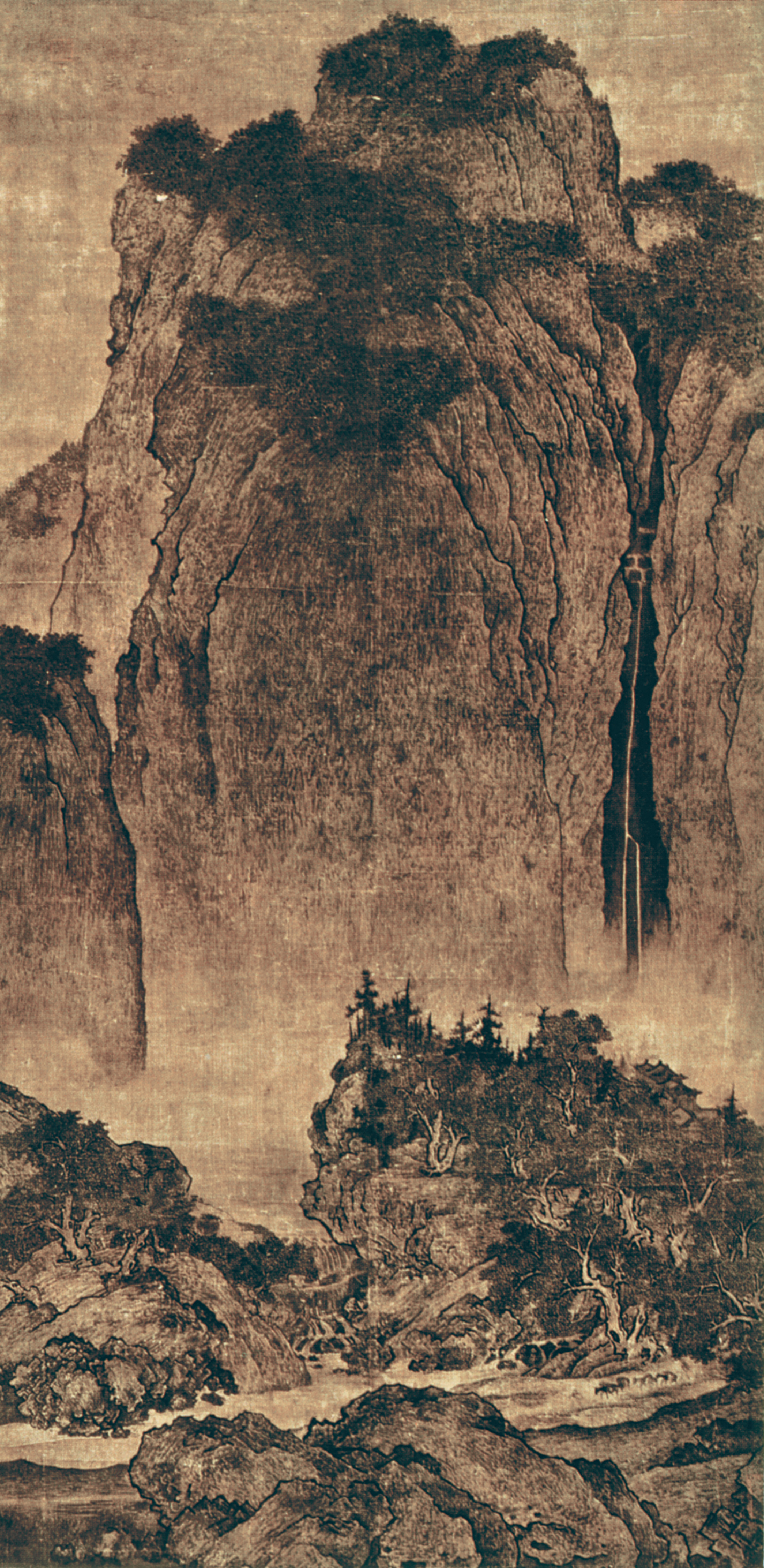
Travelers Among Mountains: Hanging scroll, ink and colors on silk, 6′ 7 ¼″ x 3′ 4 ¼″
found in Kaifeng, China
Northern Song Period
960 CE - 1127 CE
Your eBook, Kleiner Art Through the Ages, 15th edition, describes the image as follows. "In Travelers among Mountains and Streams, Fan, following Li’s example, painted a vertical landscape of massive mountains rising from the distance. But in Fan’s mountainscape, there are no buildings, and the overwhelming natural forms dwarf the few human and animal figures (for example, the mule train in the lower right corner), which the artist reduced to minute proportions. The nearly 7-foot-long silk hanging scroll cannot contain nature’s grandeur, and the landscape continues in all directions beyond its borders. Fan showed some elements from level ground (for example, the great boulder in the foreground), and others obliquely from the top (the shrubbery on the highest cliff). The shifting perspectives direct viewers’ eyes on a vicarious journey through the mountains. To appreciate the painted landscape fully, observers must focus not only on the larger composition but also on intricate details and on the character of each brushstroke. Numerous “texture strokes” help model massive forms and convey a sense of tactile surfaces. For the face of the mountain, for example, Fan employed small, pale brush marks, the kind of texture strokes the Chinese call “raindrop strokes.”"
Monumental Landscape Painting, of which this is one of the earliest and best examples, celebrates the magnitude and the beauty of nature. Whether the actual size of the painting is large or small, the concept behind the representation is one of nature is always is monumentality.
Form
Silk hanging scroll - a living format invented by the Chinese and used for poetry, calligraphy, and painting, was exported to the East Asian countries, like Korea and Japan, who adopted it and continue to use it. The size can vary tremendously from a couple of feet to wall-height; but the shape is usually vertical and more narrow than wide. Several hanging scrolls can be placed side by side to cover a wall with one continuous composition. Monumental Landscape, a standard composition, is also a form. The vertical shape is generally used to create the illusion of a slice of nature dominated by a tall, single peak, or cluster of peaks in the background; the middle ground, is conceptually nearer and may contain small figure of human being going about their business; the foreground, at the bottom of the composition is the closest to the spectator.
Style
Although we can distinguish individual “hands,” generally, the artists of the 10th - Century/Northern Song Dynasty, like Fan Kuan here, are aiming for truth to nature in terms of scale, space, and detail. They use combined techniques of outlines and texture strokes to create the feeling of depth, shadow and texture of rock, tree, and water, all with ink and no (or slight) color. Painters also take advantage of blank areas of the silk to indicate mist. Is there, as in Western painting, a single light source?
Meaning
The monumental landscape painting is a visual poem to the beauties of nature and an acknowledgment of humanity’s small place in it. As such it can be said to combine Daoist and Confucian values. For some the painting is a substitute for nature, or enjoyed as if it were actually nature. We might say it is objective.
Context
The Northern Song, like the Tang Dynasty, continued the social and political practices established during the Han: Imperial rule, government by highly educated bureaucracy, who achieved their status through an examination system. These men (no women) were equally cultivated and appreciated all the fine arts: music, poetry, calligraphy, and painting; they also collected beautiful objects of craft for their studies: jade vessels, ink-stones, precious rocks that looked like mountains, porcelain, everything that symbolized and cushioned the good life.
On a Mountain Path in Spring
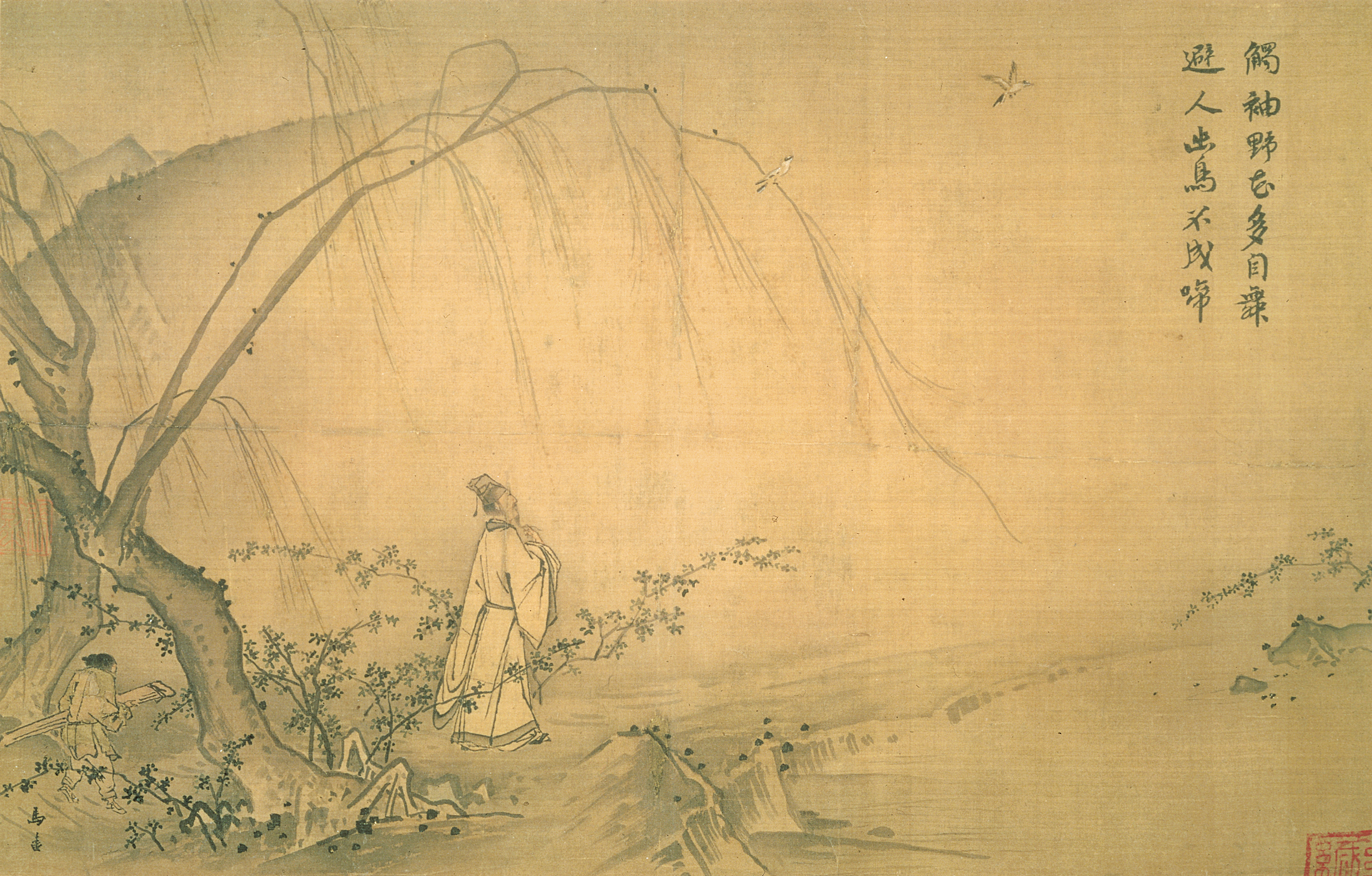
On a Mountain Path in Spring: Album leaf, ink and colors on silk, 10 ¾″ x 17″
found in Hangzhou, China
Southern Song Period
1127 CE - 1279 CE
Your eBook, Kleiner Art Through the Ages, 15th edition, describes the image as follows. "The most famous Song painters came from the Ma family, which began working for the Song dynasty during the Northern Song period. Ma Yuan (ca. 1160–1225) painted On a Mountain Path in Spring, a silk album leaf, for Ningzong in the early 13th century. In his composition, as in those of his contemporary, Xia Gui (active ca. 1195–1230), in striking contrast to Fan Kuan’s much larger Travelers among Mountains and Streams, Ma reduced the landscape to a few elements and confined the natural setting to the foreground and left side of the page. A large, solitary figure gazes out into the infinite distance. Framing him are the carefully placed diagonals of willow branches. Near the upper right corner, a bird flies toward the couplet Ningzong added in ink, demonstrating his mastery of both poetry and calligraphy:
"Brushed by his sleeves, wild flowers dance in the wind;
Fleeing from him, hidden birds cut short their songs."
The painting of the Southern Song Dynasty marks a new aesthetic, as we see in this album leaf by the Court Painter, Ma Yuan.
Form
Silk album leaf (now), but shares features with a hand-scroll in the horizontality of the silk segment.
Style
The style of Ma Yuan is the style of the S. Song Court academy: lyrical (literally, especially when, as here, it “illustrates” the lines of a poem). In opposition to the style of the Northern Song artists like Fan Kuan and Li Chen, the monumentality of nature is replaced by the intimacy of nature; notice how this composition might be a tiny detail blown up from a monumental landscape painting. The style of representation of rocks and trees depends less on texture strokes than on broad wet strokes of the brush, or washes of ink. Ma’s tendency to compose his painting with a visual emphasis on one corner earned him a nickname “one-corner Ma.” Also the presence of large amounts of “empty” space – again suggestive of mist and the unseen distance, and the large size of the figures increase the emotional, personal identification with the scene, or subjective.
Meaning
Intimate enjoyment of poetry and painting, and images of nature. Escapism: escape from reality into little, dreamy idyllic scenes. The historical/political situation suggests it.
Context
The S. Song court was driven out of the northern capital by invaders and forced to relocate to the south, where it’s power much reduced, it lived in fear of being overrun again, which eventually happened in 1368 when the Mongols conquered China.
The Song Dynasty in China
Sixth Chan Patriarch chopping bamboo
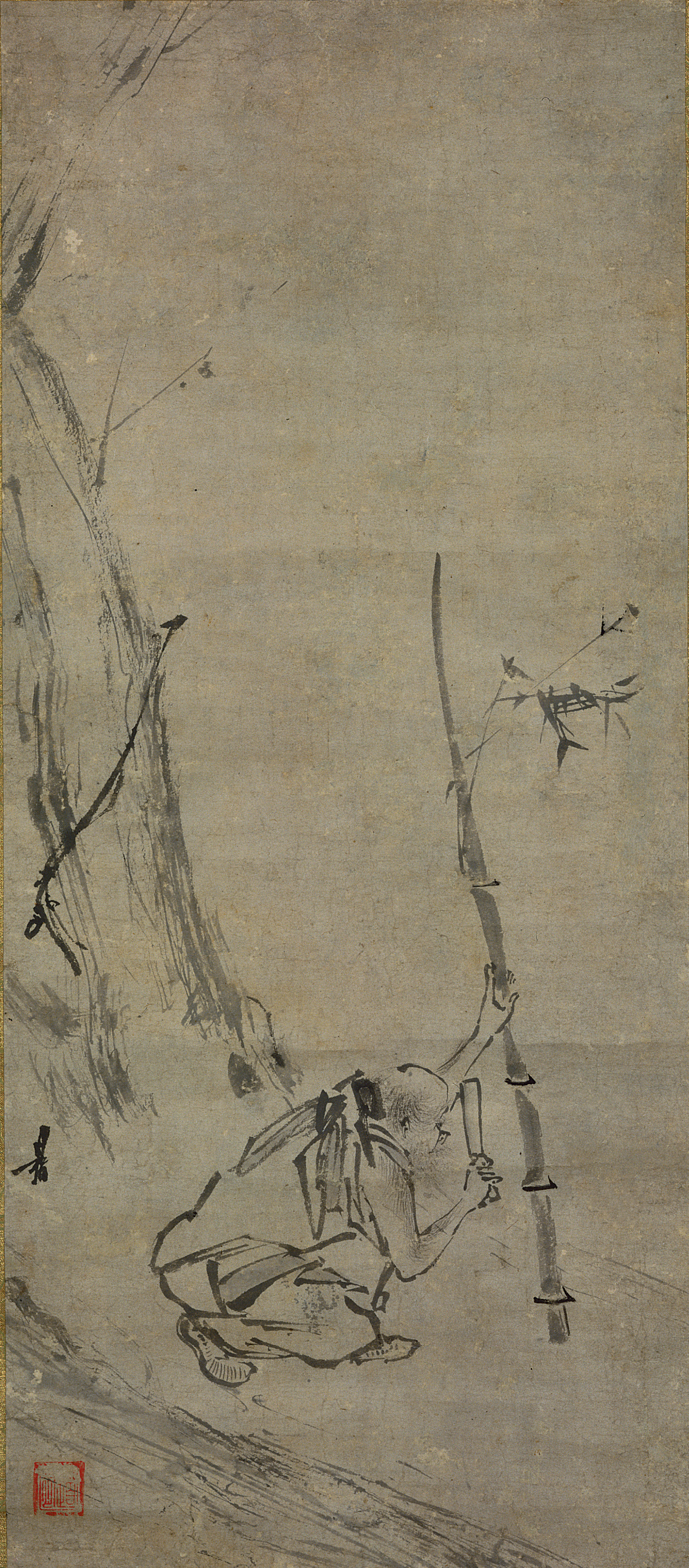
Sixth Chan Patriarch chopping bamboo: Hanging scroll, ink on paper, 2′ 5 ¼″ high.
found in Hangzhou, China
Southern Song Period
1127 CE - 1279 CE
Your eBook, Kleiner Art Through the Ages, 15th edition, describes the image as follows. "Chan Buddhism has two major schools of thought. The Northern school holds that enlightenment comes only gradually after long meditation, but the Southern school believes that the breakthrough to enlightenment can be sudden and spontaneous. Huineng, for example, achieved his “Chan moment” when he heard the sharp sound of a cutting blade strike a bamboo stick—the subject of an early-13th-century hanging scroll by the Southern Song painter Liang Kai."
One of the most important developments in East Asia was the development of Chan (Zen) Buddhism, which had reached a significant point of maturity by the Song Dynasty. According to legend, chan/dhyana/zen, the meditation sect of Buddhism, was brought to China by the Indian monk, Bodhidharma, who transmitted the doctrines to Chinese followers, known as the 6 Patriarchs. This painting by Liang Kai is an example of a new iconography of Buddhist art, and a new style of Chinese painting.
Form
Hanging scroll on paper.
Style
Minimalist; a few rapid, judiciously placed strokes and lines suggest the figure in the landscape. Compare to both N and S Song painting. Expressive, something – the sense of a momentary experience (like the sudden realization of a truth heard in the sound of a knife striking bamboo) - captured with extreme brevity of means.
Meaning
Painting can be a means through which an individual can express Buddhist/Zen truths: emptiness is form; form is emptiness; and especially the concept of non-duality, non-hierarchy; such paintings were handed down as icons equivalent to images of the Buddha, no less, no more.
Context
Painting made within the proper activities of Chinese Zen monks.
Stalks of Bamboo by a Rock
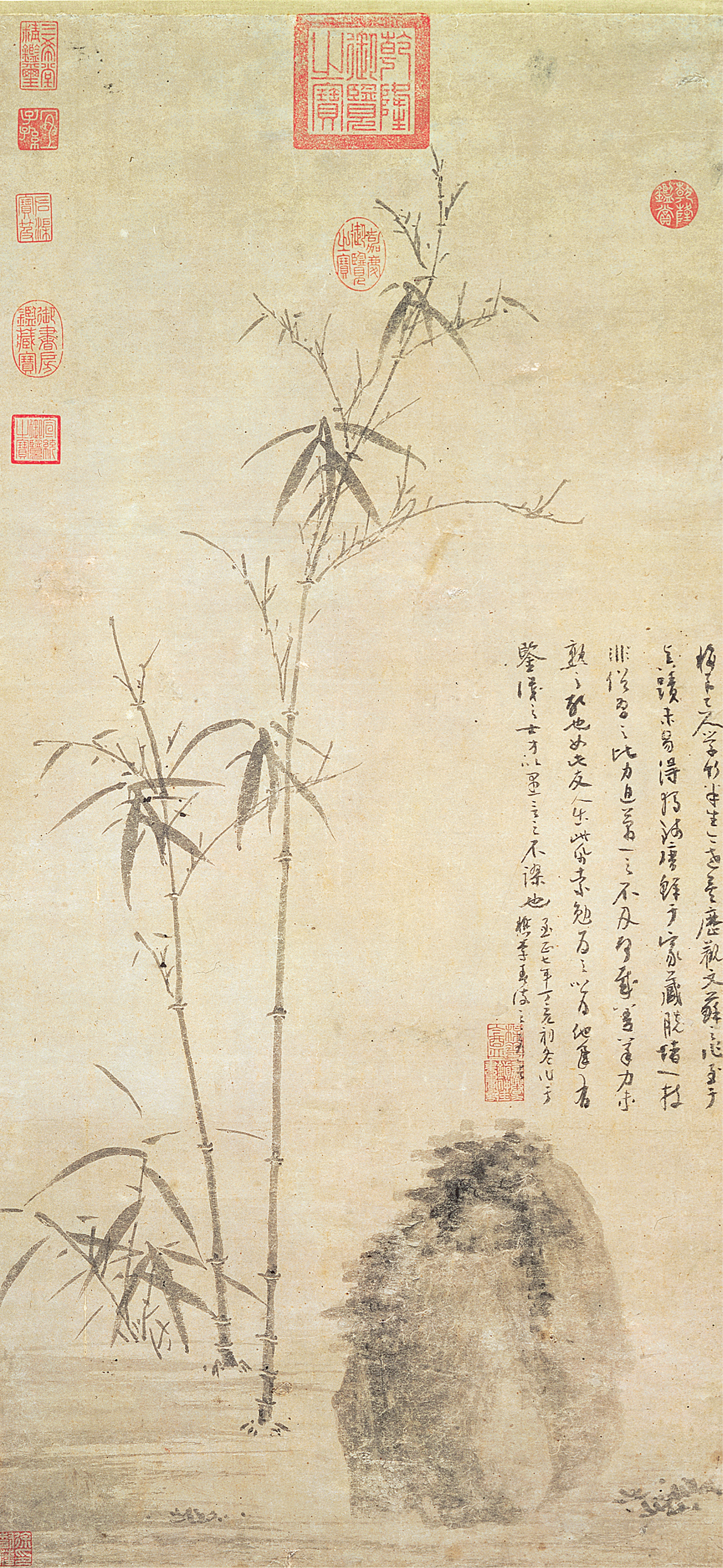
Stalks of Bamboo by a Rock: Hanging scroll, ink on paper 2′ 11 ½″ x 1′ 4 ⅜″
found in Jiaxing, Zhejiang Province
Yuan Dynasty
1279 CE - 1368 CE
Your eBook, Kleiner Art Through the Ages, 15th edition, describes the image as follows. "The artist clearly differentiated the individual bamboo plants and reveled in the abstract patterns formed by the stalks and leaves. The bamboo stalks in his hanging scroll (see “ Chinese Painting Materials and Formats ”) are perfect complements to the calligraphic beauty of the Chinese black characters and red seals so prominently featured on the scroll (see “ Calligraphy and Inscriptions ”). Both the bamboo and the inscriptions gave Wu Zhen the opportunity to display his proficiency with the brush."
An example of a work by an artist of the Literati School of Chinese painting. Literati painters belonged to the educated Chinese elite, known as the literati class; these men held the equivalent of PhD’s in Chinese history and Confucian studies, hence the term “scholar-painters.” They worked as administrators and judges within the Chinese bureaucracy, from the Song through the Qing periods. Literati painters were talented “amateurs,” free to paint any way they liked and accountable to no one. For them, painting, was like music and poetry, a means of personal expression, done in their leisure. They did not paint for patrons or money. Aloof.
Form
Hanging scroll on paper.
Style
Individual; sparse, dry, “amateurish” by design, minimalist, eccentric.
Meaning
The painting is a kind of spiritual self-portrait. The rock and the bamboo are traditional symbols for Confucian virtue, survivors in all situations of adversity. Literati painters were especially austere in the Yuan Dynasty when they had to work for the Mongols, China’s invaders, reflecting the political and social difficulties of the times. The World of Khubilai Khan: A Revolution in Painting will take you deeply into the symbolism of Yuan literati painting.
Context
The continuation of the literati’s (members of the governing bureaucracy) involvement in the fine arts. A continuation of the philosophy of Song literati, who proclaimed painting as a legitimate form of personal expression in which “truth to nature” was relative and independent of realism.
David Vases
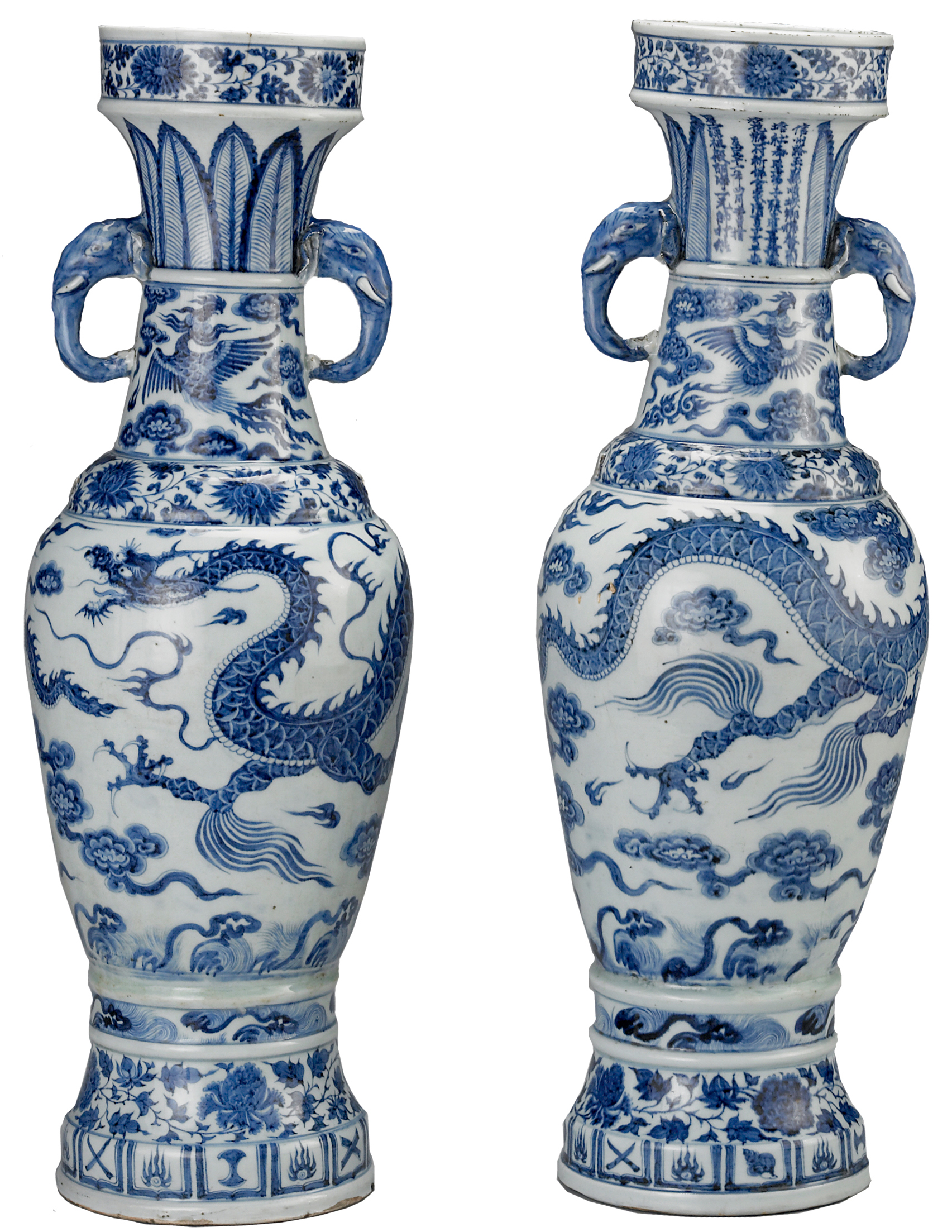
David Vases: Pair of White porcelain vases with cobalt-blue underglaze
found in Beijing, China
Yuan Dynasty
1279 CE - 1368 CE
Your eBook, Kleiner Art Through the Ages, 15th edition, describes the image as follows. "Chinese ceramists often decorate porcelains with colored designs or pictures, working with finely ground minerals suspended in water and a binding agent (such as glue). The minerals change color dramatically in the kiln. The painters apply some mineral colors to the clay surface before the main firing and then apply a clear glaze over them. This underglaze decoration fully bonds to the piece in the kiln, but because the raw materials must withstand intense heat, Yuan dynasty potters could fire only a few colors. The most stable and widely used coloring agents for porcelains are cobalt compounds, which emerge from the kiln as an intense blue. Rarely, ceramists use copper compounds to produce stunning reds by carefully manipulating the kiln’s temperature and oxygen content."
An example of the unparalleled quality and techniques of Chinese porcelain, here an example of the use of under glaze cobalt painting combined with clear over glaze produces a class of wares calls “blue and white.”
Form
Tall vases, pair; visual references to antique bronze and jade forms. Architectonic placement of painted décor: the shape of the profile suggests discreet areas, each of which has a design that “fits” it in scale and subject.
Style
Both static and dynamic movement of dragons and clouds – ancient motifs, continuing in later times.
Meaning
Auspicious symbols of good luck, imperial dragons, an element of palace decoration. Exclusively created at the porcelain center, Jingdezhen, for the imperial court.
Context
The establishment of an imperial porcelain factory at Jingdezhen signaled the power of the Emperor to control and monopolize the production of the finest wares destined for the court; also, the dedication of craftsmen to producing the most perfect and flawless pieces possible. These imperial artisans invented many secret chemical recipes for inimical colorful glazes, and decorative techniques.
Lofty Mount Lu

Lofty Mount Lu: Hanging scroll, ink and colors on paper, 6′ 4 ¼″ x 3′ 2 ⅜″
found in Suzhou, China
Ming Dynasty
1368 CE - 1644 CE
Your eBook, Kleiner Art Through the Ages, 15th edition, describes the image as follows. "Just as the formality of Ming official architecture contrasts with the informality of the gardens of Suzhou, the work of Shang Xi and other professional court painters, designed to promote the official Ming ideology, differs sharply in both form and content from the venerable tradition of literati painting, which also flourished during the Ming dynasty. As under the Yuan emperors, Ming literati practiced their art largely independently of court patronage. One of the leading figures was Shen Zhou (1427–1509), a master of the Wu School of painting, so called because of the ancient name (Wu) of the city of Suzhou. Shen came from a well-to-do family of scholars and painters and declined an offer to serve in the Ming bureaucracy in order to concentrate on poetry and painting. Lofty Mount Lu, perhaps his finest hanging scroll, was a birthday gift to one of his teachers. It bears a long poem that the artist composed in the teacher’s honor (see “ Calligraphy and Inscriptions on Chinese Paintings ”). Shen had never seen Mount Lu, but he stated that he chose the subject because he wished the lofty mountain peaks to express the grandeur of his teacher’s virtue and character. Shen suggested the immense scale of Mount Lu by placing a tiny figure at the bottom center of the painting, sketched in lightly and partly obscured by a rocky outcropping."
Shen Zhou was one of the most revered Literati painters of the Ming Dynasty; this is one of his masterpieces. Shen Zhou belonged to the ruling class elite by birth and education, but did not go into government service, but remained an amateur painter.
Form
Monumental hanging scroll on paper.
Style
A version of the Northern Song monumental landscape style of Fan Kuan and Li Cheng. Literati artist might stick to one personal style, or in homage to the great artists of the Chinese past, paint in the style of ancient great masters, as he has done here. However, it is not a “copy,” but an homage “in the style of.” And unlike N. Song monumental landscape painting is more personally expressive than objective.
Meaning
As the text explains, this is an imaginary portrait of the famous Mt. Lu, made in homage to his teacher as a birthday present. A single small figure of a scholar looks out over the river in perfect contentment. Compare to photographs.
Context
The elite world of literati painters continues; these artists often belonged to groups, coteries, in which they shared their work and socialized; although some did, out of financial necessity sell their work, the ideas was to remain an “amateur.” This reveals, at the bottom, a strong sense of social class distinction.
Auspicous Objects
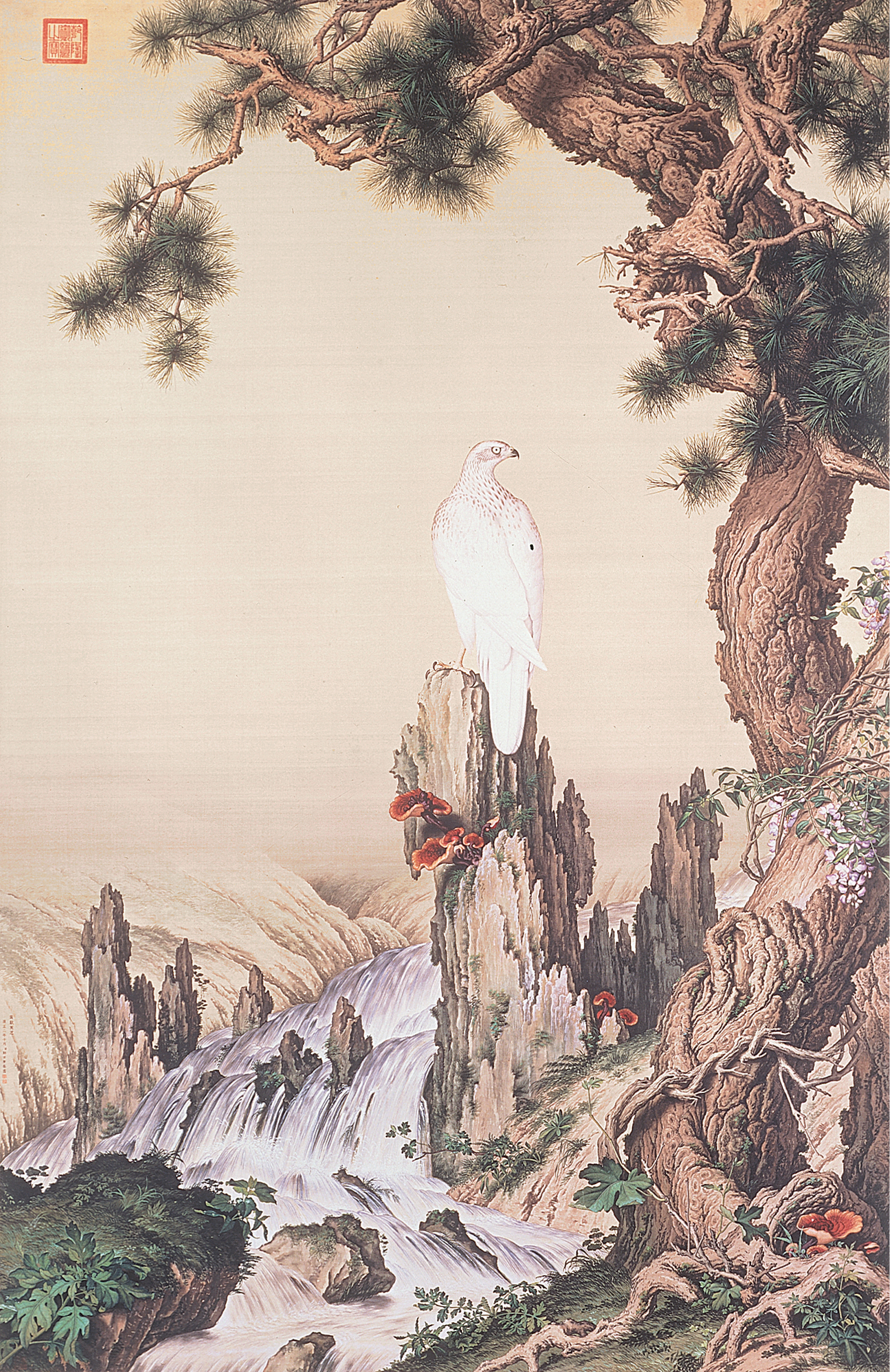
Auspicous Objects: Hanging scroll, ink and colors on silk, 7′ 11 ⅜″ x 5′ 1 ⅞″
found in Beijing, China
Qing Dynasty
1644 CE - 1911 CE
Your eBook, Kleiner Art Through the Ages, 15th edition, describes the image as follows. "The Chinese, while admiring the Europeans’ technical virtuosity, found Western style unsatisfactory. Those Jesuit painters who were successful in China adapted their styles to Chinese tastes. The most prominent European artist at the Qing court was Giuseppe Castiglione (1688–1768), who went by the name Lang Shining in China. Auspicious Objects, which Castiglione painted in 1724 in honor of the birthday of the third Qing ruler, the Yongzheng (Concord and Rectitude) emperor (r. 1723–1735), exemplifies his hybrid Italian-Chinese painting style. The Jesuit painter’s emphasis on a single source of light consistently cast shadows, and three-dimensional volume is unmistakably European stylistic concerns. But the impact of Chinese literati painting on the Italian artist is equally evident, especially in the composition of the branches and leaves of the overhanging pine tree and the rock formations in the lower half of the scroll. Above all, the subject is purely Chinese. The white eagle, the pine tree, the rocks, and the red mushroomlike plants (lingzhi) are traditional Chinese symbols. The eagle connotes imperial status, courage, and military achievement. The evergreen pines and the rocks connote long life, which, according to Chinese belief, eating lingzhi will promote. All are fitting motifs for a painting celebrating the birthday of an emperor."
In some ways, this is not a “Chinese” painting. The painter was an Italian Jesuit priest, a trained European oil painter, and printmaker, whose goal in China was to convert the Emperor and his Court to Christianity. His tactic was to serve as a court painter to the Emperor and obtain his trust and admiration, which he did, although he did not succeed in converting him to Christianity. This is an oddity but also a masterpiece of hybridity: Western/Chinese.
Form
Large hanging scroll on silk.
Style
Hybrid – European and Chinese techniques; aiming for realism without relying on Western methods such as chiaroscuro and local color. How would you describe it?
Flowers in a Vase
Meaning
It is command painting, not something creative or personally expressive; Castiglione is not telling us anything about himself beyond his incredible ability to adapt his style and still preserve his intention. It is a celebratory painting, one of many, made in honor of the Emperor’s birthday.
Context
There were several other Jesuits at court as well, architects, draftsmen, sculptors, and engineers, all making European marvels, like fountains and clocks, to impress the Emperor and convince him to convert. The Jesuits had been in China beginning in the late Ming.
Jesuit China missions